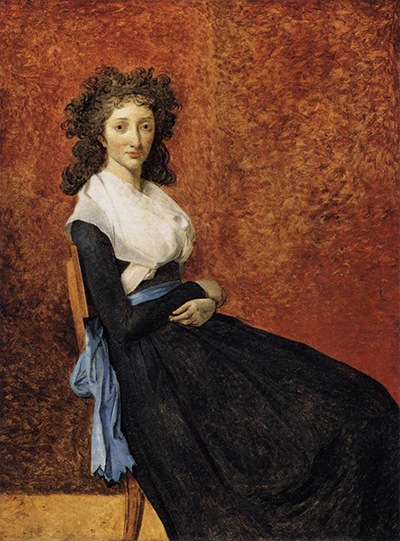Sadly, Jacques Louis David left a number of unfinished paintings behind by the time of his death in 1825. Despite that, there would still be elements of interest within portraits such as this, where much of the portraiture was actually well developed.
David is remembered for using an almost enamel-like finish on many of his perfectly executed portraits, where female faces would leap from the canvas with as much beauty as would have been seen at the time of the sitting. Such a level of quality would take time to achieve, as well as many layers of oil as the artist slowly built up the image over time. Such unfinished paintings as this, Portrait of Madame Marie-Louise Trudaine, allow us to go below some of those layers to understand more about his working processes. Within this artwork we see the young woman with arms folded gracefully, looking directly at the viewer whilst reclining back on a wooden chair. She wears a long black dress with a blue bow around her waist. There is additional touches of colour around her neck, with a white cloth hanging down over her shoulders.
The lady's hair is reasonably well kept, traditional for the time, but perhaps not as tidy as one might expect for a portrait. Her makeup is relatively modest for the period. Jacques Louis David completed a large number of portraits during his career, sometimes of friends and family in order to say thanks for help or support that they had given him, and on other occasions he would be paid handsome amounts of money in order to provide commissioned pieces for members of the upper classes. Interestingly, whilst David sometimes fell out with patrons because of his staunch backing for the revolution, the Trudaine family is known to have sensibly kept out of this conflict, at least openly, and so they remained pretty independent throughout. His own choices would later lead to his exile to Brussels, where he would ultimately live his final days.
This portrait is dated at 1791–1792, although most artworks of that period can be hard to precisely date because of the political turmoil that was going on in France at the time. David was commissioned to paint this portrait by the lady's brothers-in-law, who were well established as senior civil servants at the time. Perhaps the reason for the model's slightly pained expression may be due to the fact that she did not order the painting herself, and may not have been entirely comfortable in sitting for the artist. The piece can now be found at the Louvre, Paris, which has one of the best collections of original David paintings, and the artist even had a workshop here for a number of years.




